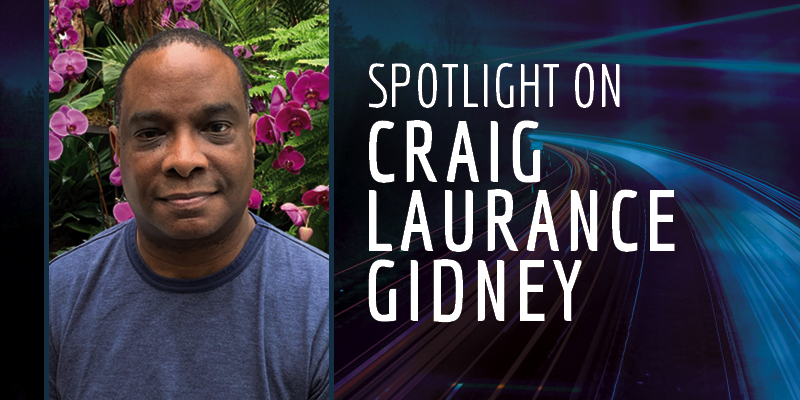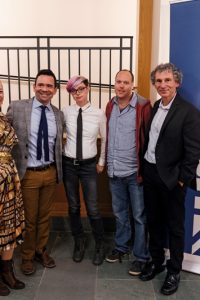Spotlight on Author: Craig Laurance Gidney

Craig Laurance Gidney is the author of Sea, Swallow Me & Other Stories; Skin Deep Magic: Stories; Bereft (a YA novella), and A Spectral Hue (a novel). He has been a Lambda Literary Finalist three times, was a Carl Brandon Parallax Award Finalist, and won the inaugural Joseph S Pulver Sr Award for Weird Fiction. The Nectar of Nightmares is his most recent collection. He lives in Washington DC.
Your latest collection came out recently, The Nectar of Nightmares from Underland Press. Tell us about the collection, and the similarities and differences with your previous collections.
The book came about because Darin Bradley of Underland Press asked me if I had a novella that needed a home. I told him that I had an entire collection of stories if he wanted to take a look. So I scrambled through my recent catalog of uncollected pieces and quickly discovered a through-line.
My first two collections, Sea, Swallow Me and Skin Deep Magic, are a mixture of genres – sort of a slipstream mix of fantasy, horror, and contemporary fabulism. Sea, Swallow Me featured mostly queer male characters, while Skin Deep Magic had mostly female characters.
The Nectar of Nightmares differs from those collections because it really leans into my type of horror fiction – strong on the vibes, full of ambiguity. There’s cosmic horror, dark retellings of folk and fairy tales (a retold Tar Baby tale and a male-male Beauty and the Beast variant); an oblique nod to the King in Yellow mythos, an ode to Emily Brontë, and fashion horror in the drag ball scene.
Tell us about one or two stories from the collection that you’d like to highlight.
“Black-Winged Roses” required the most research and was a real balancing act weaving fantasy into a historical context. The story is a prequel to my stories “Conjuring Shadows” and “Coalrose” both collected in Skin Deep Magic, but it stands on its own. Like those stories, it’s set during the Harlem Renaissance. It takes place in an underground queer speakeasy and features two powerful conjure-women – the transwoman owner of the club and a pianist-singer. It is about the fire-forged sisterhood the two of them form.
The title story, “The Nectar of Nightmares” is the final story in the collection. “The Nectar of Nightmares” really started my career as a weird-fiction/horror writer. It first came out as chapbook from Dim Shores Press (illustrated by Orion Zangara) in 2015, and I consider it an exemplar of my approach to dark fiction – dreamy, otherworldly, and centering marginalized characters. It’s a mosaic story about three disparate people – a child ballerina, a young Diné lesbian, and a homeless Gulf War veteran – and their encounters with a demon who feeds on bad dreams.
What work of yours beyond the collection would you like to point our readers toward?
I would point them to Baffling Magazine, the online ’zine I co-edit with dave ring and Gabriella Etoniru. Baffling publishes queer speculative flash fiction. There are stories full of terror, wonder, and humor – all below 1,500 words. Plus, the art that ring curates is simply amazing. Baffling has published established authors, like Jewelle Gomez, alongside relatively new authors. Reading submissions has influenced my own fiction – it’s wonderful what you can do with the form! In fact, the Neon Hemlock Press aesthetic overlaps with the Gidney aesthetic – weird and queer.
What’s the particular appeal of dark fantasy and horror for you?
For a long time, I resisted being labeled a “horror writer” because, like a lot of folks, I associated horror with gore. Now, I realize that horror can be subtle and disquieting. It can be a vibe. Shirley Jackson isn’t a gorehound, but her work is very much “horror fiction.” Now, I embrace being a horror writer, though maybe “weird fiction” might be closer to what I do. I’ve always been interested in the grotesque, how things we label grotesque are often quite beautiful. Orchids, for instance, are beautiful flowers but they exist in a pseudo-parasitic relationship with a host plant. Butterflies are beautiful, delicate things but they come from a mushy cocoon where their caterpillar selves are liquified.
I love dark fantasy for the imagery that writers use to describe their worlds. Genre fiction often gets derided by mainstream and literary writers, but some authors are absolutely stylists! The late Patricia A McKillip was a gateway author for me. Her work on the sentence level is astounding – images within images, like nesting dolls. After McKillip, came the dark fantasist Tanith Lee. Reading her work was like moving through a dream. I tend to be drawn to writers who play with language, and they have the perfect excuse to write opiate prose. But I also like pared down styles – like Octavia E. Butler’s work. Her sentences flex like muscles and every word belongs there. That style fits perfectly with brutality she writes about. And I like all styles in between, too!
I think my work, particularly in The Nectar of Nightmares, crosses and recrosses the borderline between dark fantasy and horror.
Your novel, A Spectral Hue, received a lot of recognition. Any plans to write another novel?
I was surprised and honored at the reception that A Spectral Hue has gotten. Horror fans, Black and Queer Lit readers all have gotten something from reading the novel. In addition to being shortlisted for awards, it’s being taught in college classes! It’s a daunting task to write a followup!
I’m currently writing two novels. One is a fairytale novel about otherness and isolation. It’s Tanith Lee meets Toni Morrison, with a sprinkle of Neil Gaiman. The other is a chaotic story about religion, Blackness, and queerness. Think The Exorcist meets Song of Solomon with notes of Go Tell It on the Mountain and Dhalgren.
Is there anything else you’d like our readers to know about you or the work you do?
I am a native of Washington, DC and have seen my share of politicians. DC is known for politics but it has a rich magical history apart from Capitol Hill. For instance, many people of the Harlem Renaissance (Langston Hughes, Richard Bruce Nugent and Zora Neale Hurston) lived in the District at one point. In fact, my current house is directly in front of the house that Zora Neale Hurston lived when she went to Howard University. (I wrote a story about Hurston in my second collection.) I want to write an epic Secret History fantasy novel about city at some point.
Cover and interview design by Stephen H. Segal
While you are here, please take a moment to support Locus with a one-time or recurring donation. We rely on reader donations to keep the magazine and site going, and would like to keep the site paywall free, but WE NEED YOUR FINANCIAL SUPPORT to continue quality coverage of the science fiction and fantasy field.
©Locus Magazine. Copyrighted material may not be republished without permission of LSFF.









